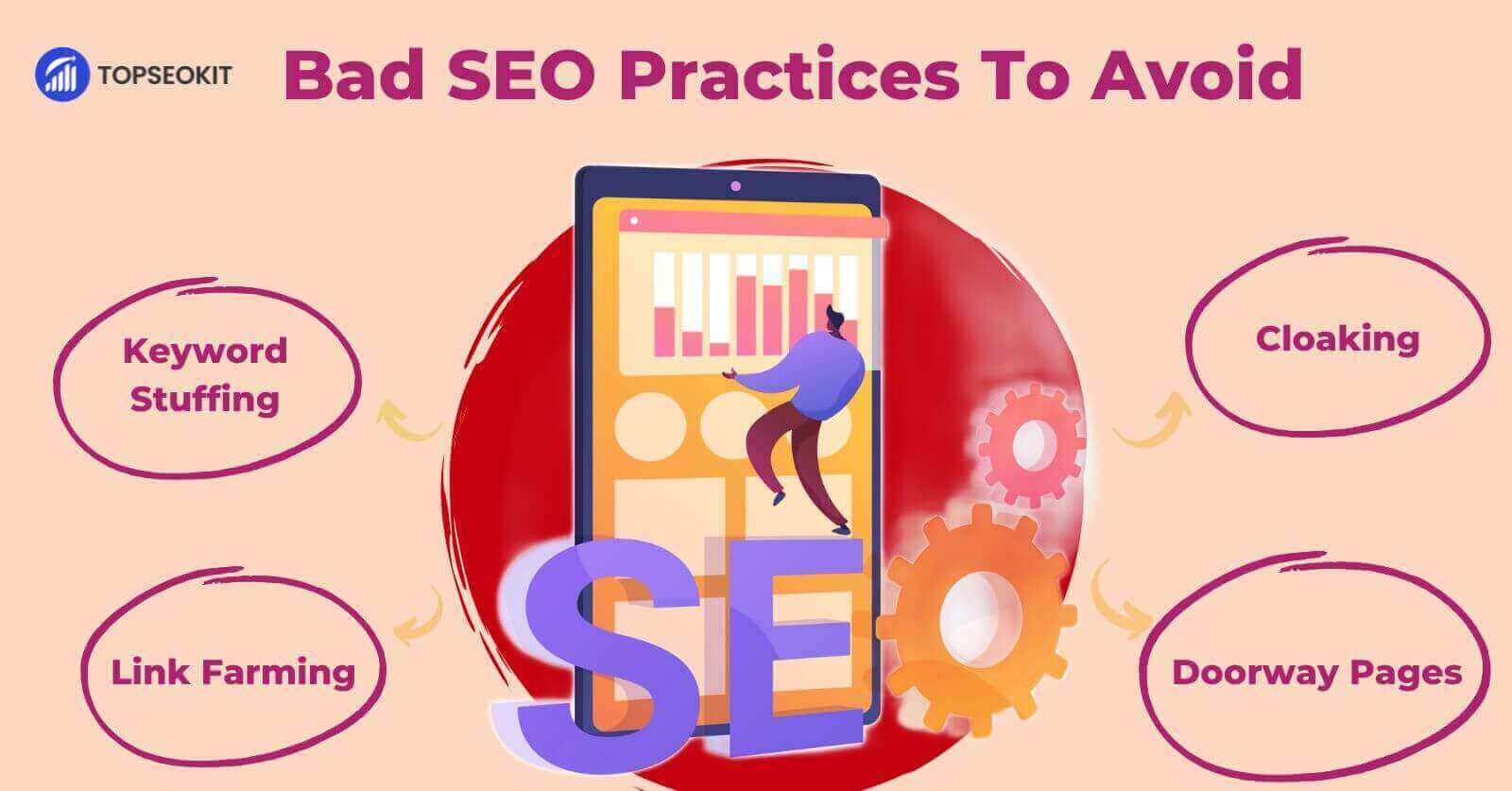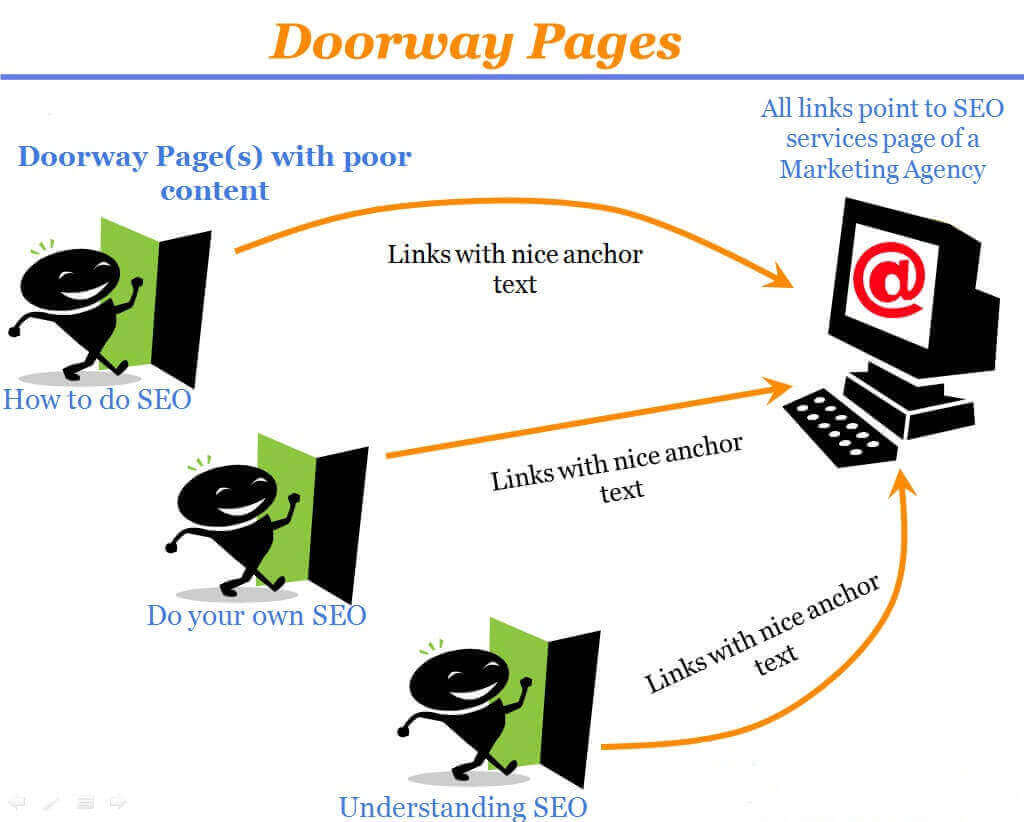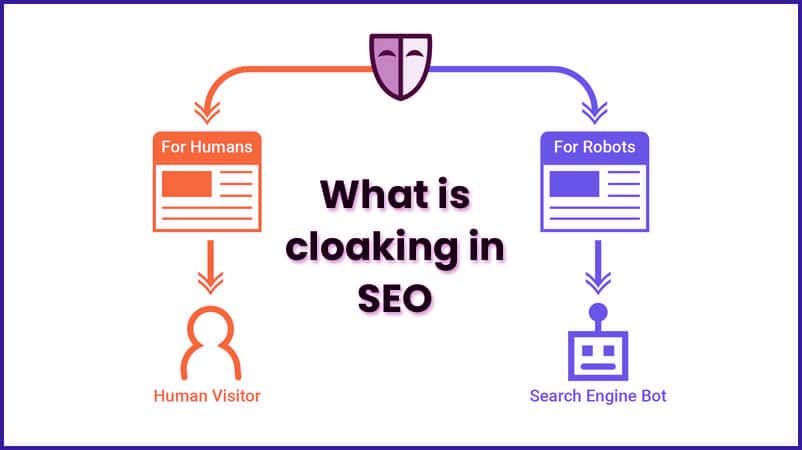
Avoid These Bad SEO Practices for Better Results
Lets learn about ten bad SEO practices that you should avoid at any cost.
Search Engine Optimization is optimizing a website to improve its visibility and ranking on SERPs. However, there are also bad SEO practices that can harm a website’s ranking and visibility. These practices involve using unethical techniques to manipulate search engine algorithms and trick users into clicking on their websites. These practices can result in penalties from search engines, lower rankings, and damage to a website’s authority. You might be practicing different SEO techniques without even wondering which of these is a bad SEO practice.
Businesses need to understand the difference between good and bad SEO practices. By using ethical SEO techniques, businesses can improve their rankings, attract more traffic, and build a stronger online presence.
Ten Bad SEO Practices you should avoid:
These are the top 10 bad SEO examples:
1. Keyword Stuffing

Keyword stuffing is an unethical SEO practice involving excessive keyword use in a webpage or article to manipulate search engine rankings. The practice entails repeating specific keywords or phrases multiple times, even if they are irrelevant or do not add any value to the content. The main goal of keyword stuffing is to deceive search engines into believing that a webpage is highly relevant to a particular search term.
Also Read: How long article should be for SEO?
Negative effects of keyword stuffing:
The negative effects of keyword stuffing can be significant. Firstly, it can lead to a poor user experience by making the content difficult to read and understand. Secondly, it can result in search engines penalizing the website by lowering its ranking or even removing it from search results. Thirdly, it can damage the website’s reputation and credibility, leading to a decrease in organic traffic and conversions.
Examples of keyword stuffing:
Examples of keyword stuffing include repeating the same keyword or phrase multiple times within meta tags, meta descriptions, headers, and webpage content. For instance, a sentence such as “We sell the best dog food for dog owners who want to buy dog food online. Our dog food is the best dog food for all types of dogs” is an example of keyword stuffing as the keyword “dog food” is repeated excessively, making the content sound unnatural and spammy.
2. Keyword Cannibalization
Keyword cannibalization occurs when multiple pages on a website target the same keyword or phrase. This often happens unintentionally when a website has multiple pages with similar content or when a website owner creates multiple pages with the same keyword to dominate search results for that term. When search engines crawl a website, they may have difficulty determining which page is the most relevant for a particular keyword. As a result, the pages may compete for search engine rankings, which can lead to a decrease in rankings for all pages targeting the same keyword.
Negative Effects of Keyword Cannibalization
The negative effects of keyword cannibalization include decreasing overall search visibility and traffic for the affected pages. When multiple pages on a website are competing for the same keyword, it can be challenging for search engines to determine which page is the most relevant for that keyword. This can lead to a decrease in rankings for all pages targeting the same keyword, as well as a decrease in overall search visibility and traffic for the website.
Examples of Keyword Cannibalization
An example of keyword cannibalization is a website with multiple pages targeting the same long-tail keyword. For example, suppose a website has a blog post targeting “best-running shoes for women” and a separate product page targeting the same keyword. In that case, search engines may have difficulty determining which page is the most relevant for that keyword. This can lead to a decrease in rankings for both pages, as well as a decrease in overall search visibility and traffic for the website.
3. Doorway Pages

Doorway pages, also known as gateway pages or entry pages, are web pages that are created specifically to rank highly in search engines for particular keywords or phrases. They are designed to manipulate search engine rankings by directing visitors to a different page than they were expecting to find. Doorway pages often have little or no unique content, and they typically contain a list of links to other pages on the website. They are not intended to be seen by human visitors, but rather to be detected by search engine crawlers.
Negative Effects of Doorway Pages
The negative effects of doorway pages include a decrease in overall search visibility and traffic for the affected website. Search engines consider doorway pages to be a form of spam, and they may penalize websites that use them by lowering their search rankings or even removing them from search results altogether. Additionally, using doorway pages can harm a website’s reputation and credibility, as it appears to be manipulating search engine results rather than providing valuable content to visitors.
Examples of Doorway Pages
An example of a doorway page is a web page that has been designed to rank highly for a particular keyword or phrase, but which provides little or no useful content to visitors. These pages often contain keyword-stuffed content irrelevant to the page’s topic or purpose. Another example of a doorway page is designed to redirect visitors to another page on the website rather than providing helpful information or engaging content.
4. Article Spinning

Article spinning is a black hat SEO technique that involves using software to create multiple versions of an original article by changing its wording, sentence structure, and synonyms to make it appear as if it is unique content. The goal of article spinning is to create a large number of low-quality articles quickly and easily for the purpose of generating backlinks and improving search engine rankings.
Negative Effects of Article Spinning
The negative effects of article spinning include a decrease in the quality of content available on the internet and a reduction in the credibility and authority of websites that use this technique. Search engines like Google have become increasingly adept at detecting spun content. They may penalize websites that use this technique by lowering their search rankings or removing them from search results altogether. Additionally, article spinning often results in content that is difficult to read and understand, making it less helpful to visitors.
Examples of Article Spinning
An example of article spinning is taking an original article and using software to automatically create multiple versions by replacing words with synonyms or using different sentence structures. These spun articles may appear unique but often contain awkward phrasing and repetitive language. Another example is taking multiple articles on the same topic and using software to create a single “spun” article that contains content from all of them.
5. Irrelevant Link Building

Irrelevant link building refers to the practice of acquiring backlinks from websites that are not related to your industry or niche. The goal of this technique is to increase the number of backlinks to a website without regard to its quality or relevance. Irrelevant links may come from websites that are spammy, low-quality or have no relationship to the content of the website being linked to.
Negative Effects of Irrelevant Link Building
The negative effects of irrelevant link building include a decrease in search engine rankings, reduced credibility and authority of the website, and even penalties from search engines such as Google. Search engines evaluate the quality and relevance of a website’s backlinks to determine its authority and credibility. Irrelevant links may be viewed as an attempt to manipulate search engine rankings and can result in penalties that negatively impact a website’s visibility and traffic.
Examples of Irrelevant Link Building
An example of irrelevant link building is when a website that sells shoes acquires backlinks from websites related to cooking or gardening. Another example is when a website acquires many backlinks from low-quality directory sites or link farms. To avoid the negative effects of irrelevant link-building, it is important to focus on acquiring high-quality, relevant backlinks from reputable sources related to your industry or niche.
6. Cloaking

Cloaking is a black hat SEO practice that shows different content to search engine crawlers and users. In cloaking, the website owner will create two webpage versions, one for search engine crawlers and one for users. The version shown to search engine crawlers will be stuffed with keywords, while the version shown to users will be optimized for a better user experience.
Negative effects of cloaking:
Cloaking is considered an unethical SEO practice and can have severe negative consequences for a website. Firstly, search engines may detect the cloaking and penalize the website by removing it from search results or lowering its ranking. Secondly, it can harm the user experience by providing users with different content than what they were expecting, leading to a high bounce rate and a decrease in conversions. Lastly, cloaking can damage the website’s reputation, leading to decreased traffic and revenue.
Examples of cloaking:
One example of cloaking is when a website owner uses JavaScript or other code to detect when a search engine crawler visits the site and displays a different version of the page optimized for search engines. The user version of the page might be completely different in terms of layout, content, and images.
7. Link Farming
Link farming is a black hat SEO technique that involves creating a network of low-quality websites or pages that link to each other for the sole purpose of boosting search engine rankings. The goal of link farming is to artificially increase the number of backlinks to a website, which is one of the factors that search engines use to determine the authority and relevance of a webpage.
Negative effects of Link Farming:
Link farming is considered an unethical SEO practice that can have severe negative consequences for a website. Firstly, search engines may detect link farming and penalize the website by removing it from search results or lowering its ranking. Secondly, links from low-quality or irrelevant websites can harm the website’s reputation and credibility, leading to a decrease in traffic and conversions. Lastly, link farming can damage the website’s long-term SEO strategy, as search engines are constantly evolving and becoming better at detecting and penalizing black hat SEO techniques.
Examples of link farming:
One example of link farming is when website owners pay for links to their site or participate in link exchange programs with other websites solely to increase their backlinks. Another example is when website owners create multiple low-quality websites or pages and link them together to increase their search engine rankings.
8. Duplicate Content

Duplicate content refers to content that appears in multiple locations on the internet. It can be on the same website or on different websites. Duplicate content can be created intentionally or unintentionally. Intentional duplication is when someone copies content from a website and uses it on their own website without permission. Unintentional duplication can happen when the same content appears in multiple places on a website, such as on different pages or through URL variations.
Negative effects of duplicate content:
Duplicate content is an unethical SEO practice that can negatively affect a website. Firstly, search engines may have difficulty determining which version of the content is the original, resulting in lower search engine rankings for all the duplicated content. Secondly, it can harm the user experience by providing repetitive or confusing content, leading to a high bounce rate and decreased conversions. Lastly, it can damage the website’s reputation and credibility, leading to a decrease in traffic and revenue.
Examples of duplicate content:
One example of intentional duplicate content is when website owners copy content from other websites or use article-spinning tools to create multiple versions of the same article. Unintentional duplicate content can happen when website owners create multiple versions of the same page, such as through different URL structures or pagination.
9. Buying Links

Buying links is a black hat SEO technique that involves paying other websites to link to a specific website. This technique is used to artificially increase the number of backlinks to a website, which is one of the factors that search engines use to determine the authority and relevance of a webpage. Websites that engage in this practice buy their way to higher search engine rankings rather than earning them through high-quality content and ethical SEO practices.
Negative effects of buying links:
Buying links is considered an unethical SEO practice that can have severe negative consequences for a website. Firstly, search engines may detect that the links were bought and penalize the website by removing it from search results or lowering its ranking. Secondly, links from low-quality or irrelevant websites can harm the website’s reputation and credibility, leading to a decrease in traffic and conversions. Lastly, buying links can damage the website’s long-term SEO strategy, as search engines are constantly evolving and becoming better at detecting and penalizing black hat SEO techniques.
Examples of buying links:
One example is when website owners pay for sponsored content that includes website links. This practice is often disguised as a legitimate endorsement or review, but the website owner is actually paying for the link rather than earning it through quality content.
10. Hidden Text

Hidden text is a black hat SEO technique that hides web page text to manipulate search engine rankings. This can be done in various ways, such as using text the same color as the background, a tiny font size, or placing the text behind an image or other element on the page. The purpose of hidden text is to include keywords and other content that can help boost a page’s ranking without displaying that content to human visitors.
Negative effects of hidden text:
Hidden text is considered a deceptive and unethical practice that can result in severe penalties from search engines. When search engines detect hidden text, they may penalize the website by lowering its ranking, removing it from search results, or even banning it from the search engine altogether. Additionally, hidden text can harm the user experience by making the page difficult to read or navigate, leading to a decrease in traffic and conversions.
Examples of hidden text:
One example is when website owners use the same text color as the background to hide links to other site pages or external websites. This practice is often used to create a “link farm” or to promote affiliate products without being obvious to visitors. In some cases, hidden text can be used to display irrelevant or offensive content to human visitors while still providing on-page SEO benefits to the website owner.
Conclusion
In this article, we have discussed some of the most common bad SEO techniques that website owners and marketers should avoid. These practices are considered unethical and can result in severe penalties from search engines. However, ethical and transparent SEO practices are essential for building a solid online presence and attracting more traffic to a website. In contrast, using bad SEO strategies can harm a website’s reputation, decrease traffic and conversions, and ultimately lead to the failure of the business. Therefore, it is crucial for website owners and marketers to prioritize ethical and transparent SEO practices and avoid any tactics that may be perceived as deceptive or manipulative.
FAQS
What are some examples of bad SEO practices?
Some bad SEO practices include keyword stuffing, cloaking, buying links, using irrelevant or low-quality backlinks, plagiarizing content, and creating pages with little to no original content.
Why are bad SEO practices harmful to a website’s ranking?
Search engines such as Google penalize websites that engage in bad SEO practices by lowering their ranking or even removing them from search results altogether. This is because bad practices violate search engine guidelines and can lead to a poor user experience. Additionally, users may not trust or engage with a website that engages in manipulative tactics.
How can website owners avoid bad SEO practices?
Website owners can avoid unethical SEO practices by staying up-to-date on search engine guidelines, working with reputable SEO professionals, and focusing on creating high-quality, original content. It is also important to avoid shortcuts and quick fixes and instead focus on building a strong, sustainable SEO strategy over time.
Explore More:
Ethics In Social Media Marketing One Must Follow
Let’s dive in! Get started for free
